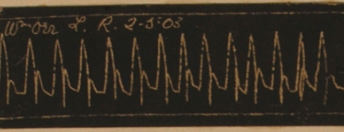Dr Dorothy Lunt
Dr Dorothy Lunt
Click on the links below to hear Dr Lunt talk about
I graduated in 1953. Having been part of the second intake of BDS students. Before that of course, students were qualified by the College of well, then the Faculty of Surgeons and Physicians in Glasgow. And there was an idea that the BDS course started in 1948. I was accused of being in the first year of BDS students. This is not so. I was the second year of BDS students, there was a year ahead of me who started in ’47. So ’48 to ’53, I was a student.
I remember it being very hard work. We had classes from nine in the morning until six in the afternoon, without any time off whatsoever. And then one had to go home in the evening and during the evening and at weekends one had to do all the learning process. I used to envy the arts students, less so the science students, who seemed to have about two lectures a week and the rest of the time to themselves, which was something I never had. Didn't even have long holidays in the summer because we had an extra term in August, the Lamas term, during which we had to come into the Dental School, mostly to see patients.
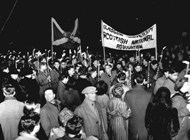 The other thing that I perhaps remember most vividly from my student years was that the fifth centenary fell during my time as a student, 1951 of course. And it so happened that was, none of them were easy but this by comparison was the easiest year of the course. And so that meant I actually could afford to take part in the celebrations. And I remember the procession from the square outside the cathedral where classes first started, with torches lit from the torch that the runners had carried all the way from Bedrule in the Borders where Bishop Turnbull had been born. We lit our torches from his torch and then we all went in procession with the torches burning up to Gilmorehill. And then there was a huge bonfire, and the fireworks display and the thing that impressed me most of all, five great searchlight beams up behind the University, one for each hundred years. And of course everything had been very much austerity since the war. We were still on rationing. And an occasion like this was something so splendid, it was almost unbelievable.
The other thing that I perhaps remember most vividly from my student years was that the fifth centenary fell during my time as a student, 1951 of course. And it so happened that was, none of them were easy but this by comparison was the easiest year of the course. And so that meant I actually could afford to take part in the celebrations. And I remember the procession from the square outside the cathedral where classes first started, with torches lit from the torch that the runners had carried all the way from Bedrule in the Borders where Bishop Turnbull had been born. We lit our torches from his torch and then we all went in procession with the torches burning up to Gilmorehill. And then there was a huge bonfire, and the fireworks display and the thing that impressed me most of all, five great searchlight beams up behind the University, one for each hundred years. And of course everything had been very much austerity since the war. We were still on rationing. And an occasion like this was something so splendid, it was almost unbelievable.
It became obvious to me when I was in final year and seeing a lot of patients a lot of the time that I did not really enjoy handling patients. It wasn't that I didn't like doing the actual physical work on the teeth in the patient's mouth. That I quite enjoyed doing but I was aware that I wasn't really fast enough. If I tried to go faster it simply meant that that the quality of my work deteriorated. I wasn't going to have that. But I knew that I would never satisfy the principle in Practice. And also I found it very hard work coping with patients psychologically. Because in those days we were really not allowed to give local anaesthetics except in extreme occasions and you had a frightened patient who you knew was going to be suffering pain and you were inflicting the pain. And somehow you had to cope with them, that you could get them to sit still in the chair and accept this pain as something necessary. And I found this a tremendous mental drain, at the end the day I'd be absolutely exhausted by this.
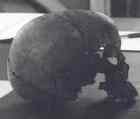 And he [Pofessor V Moller-Christense] had managed to persuade the Danish government to build him a museum. [Aebelholt Klostermuseum] Just shows what governments will do in other countries. I am sure none of our governments would ever have done this but the Danish government were prepared to put up the money to build a museum beside this excavated monastery specially to house the skeletons. And he had a display there. He was interested in pathological conditions and he had a display in this museum of all the most interesting pathological conditions and then all the rest of the skeletons were stored up in the loft. And he had built into this museum a special little room for visiting scholars where you could actually stay. There was a camp bed, a rather uncomfortable camp bed, and a gas ring and a kettle. You could kind of look after yourself there. And so in the summer of 1963 I spent the whole summer vac working, partly in Copenhagen because some of the material was in Copenhagen but partly at Aebelholt out in the countryside working on, I used to tell my friends, "I had been living, working, eating, sleeping with 750 skeletons!" and that really used to make them shriek in disgust. But I got on there fine and that gave me the data that I could put together for the PhD which I was awarded in 1966.
And he [Pofessor V Moller-Christense] had managed to persuade the Danish government to build him a museum. [Aebelholt Klostermuseum] Just shows what governments will do in other countries. I am sure none of our governments would ever have done this but the Danish government were prepared to put up the money to build a museum beside this excavated monastery specially to house the skeletons. And he had a display there. He was interested in pathological conditions and he had a display in this museum of all the most interesting pathological conditions and then all the rest of the skeletons were stored up in the loft. And he had built into this museum a special little room for visiting scholars where you could actually stay. There was a camp bed, a rather uncomfortable camp bed, and a gas ring and a kettle. You could kind of look after yourself there. And so in the summer of 1963 I spent the whole summer vac working, partly in Copenhagen because some of the material was in Copenhagen but partly at Aebelholt out in the countryside working on, I used to tell my friends, "I had been living, working, eating, sleeping with 750 skeletons!" and that really used to make them shriek in disgust. But I got on there fine and that gave me the data that I could put together for the PhD which I was awarded in 1966.
I think probably one of the most interesting results of the work that I did was in dental paleopathology and there one could show very clearly what had I must admit been also shown for English material that there was a gradual increase in dental caries from the earlier periods to the later ones.
I used to say to people sometimes when they were agonising over how can we get people's teeth to be better in the 20th century, not have quite so much dental caries. I used to say, "Put them on a Bronze Age diet and you'll get rid of virtually all the dental caries!"
Professor Andrew Ross Lorimer
Professor Andrew Ross Lorimer
Listen to Professor Lorimer talk about
![]() My interest in studying medicine
My interest in studying medicine
I graduated in 1960. There was a sort of family history of medicine. I had a cousin that was in medicine and also it was the early days of the Health Service. And so that I think the interest was before 1954, before I went to medical school. I think the Health Service was seen as an absolutely fantastic opportunity to improve the health of the people. And people could get medical care without paying for it and without being worried about whether or not they could pay for it and we were all very enthusiastic about that aspect of the development of this in this country.
We went up to University in October, 1954. Some of the people had been at Freshers' Camp but I hadn't been. So we stood outside the zoology building on a very cold day in November and those were the days, all the boys were in their new university blazers, their university ties and their pearly grey flannel trousers. Some of the girls had blazers too. It was quite a different scene from that which happens nowadays. And we went in to the zoology lecture theatre where Professor Wishart, who was the Dean of the Faculty of Medicine at that time, he was a physiologist, a very nice man. And he told us a little bit about the course and what was expected of us and what was not expected of us. And then we started.
All I can remember was we ate in the Union every day and it was very interesting. I remember the five hundred pie club, because if you ate five hundred pies you were supposed to get a free meal. Don't think we ever did but we had a pie, a scoop of mashed potatoes and a little bottle of milk for seven pence. And that enabled you to save enough money to perhaps take somebody out at the weekend.
Cardiology was just starting to develop heart surgery mitral valvotomy with Professor Mackie. I was his resident and I did two months in the cardiac surgery unit with a very excellent group of people. Ralph Thomson was the physician and the surgeons, Professor Mackie, Bill Bain and Murdo Turner were absolutely excellent to work with. And I mean, they were starting to push back the frontiers there and that was extremely interesting. And you would see these women with rheumatic fever who were extraordinarily breathless and couldn't have children. We all recognised that the operation was palliative rather than curative. But many of them in skilled hands would get many years of very good active life and see their children grow up. I think that was what put me into cardiology. It was a specialty that was developing some form of intervention and treatment.
Heart attacks, came into the general ward. They weren't put in coronary care units. John Kennedy and I put in the first pacemaker in the Royal Infirmary. John and I did the first coronary angiogram in the Royal Infirmary. And now these things which they now do six a day, you know we did one a week. And it was a major event to co-ordinate the X-ray, borrowing it from X-ray and trying to get a nurse from somebody else.
And we used to have to open chests at the Gatehouse to try and do cardiac massage and then the defibrillators came along. And again John Kennedy and I were heavily involved the development of defibrillation and training. And I always remember John, in the early days of the coronary care unit, a patient that he was taking a history from went into ventricular fibrillation which would have meant death a year before. John defibrillated the patient and then picked up his paper and case sheet again and said "Now as you were saying". Very dramatic.
And I think one of the other things that certainly had changed was that many of us stopped being purely interventionists and treating disease to actually becoming involved in prevention. And I think Professor Lawrie really was interested in the role of cholesterol in coronary heart disease long before it became fashionable and long before it was generally accepted. And it was a hard battle to get it accepted that it was a worthwhile thing to lower cholesterol. And of course the West of Scotland Study based in the Royal Infirmary showed conclusively that you could not prevent, but you could certainly very considerably reduce the problem of coronary heart disease by appropriate prevention. And we now know that primary and secondary prevention are very worthwhile. That wasn't practised twenty-five, thirty years ago. So, we are now into prevention. We are now into long term treatment of chronic disease. We have many more interventions. So that as I say other than a stethoscope which may or may not become redundant, we had to learn new things all the way through.
Mr Alistair John Mack & Dr Alison Mack
Mr Alistair John Mack & Dr Alison Mack
Mr Mack
Listen to Mr Mack talk about student days and Surgery
It was a great change from school, although in the 1950s a lot of us, twelve of us went up from my school to medicine at Glasgow and we all stayed at home and that was a pity because it would have been nice to have gone to a different university but there was no discussion at that time, we all went to Glasgow University. It was great fun. I made friendships that I still have today. I met my wife as a student. And the things that stand out were electives, as it was not called then but as it is now in Ballochmyle and going to Dublin to do midwifery. It was not the midwifery that stands out I must say it was going to Dublin. And many of us worked during our holidays and several of us from Paisley where I went to school worked in a hospital there as theatre orderlies or things like that. And that was good fun. And that gave us a little bit of spending money because there were no grants, at least not at that time. And you lived at home as it were, and supported by your parents.
![]() Starting a Medical School in Nairobi
Starting a Medical School in Nairobi
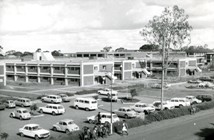 It was great fun. Glasgow University were involved in starting a medical school in Nairobi. And they sent out groups of surgeons, physicians, pathologists, obstetricians. A man and a boy, I was the boy, there was a senior chap. And, the work was very interesting, and very exciting, very varied, lots of trauma, lots of unusual things that one didn't see in this country. And my wife was able to work part time as a kind of GP to the medical staff and the children had a obviously a nanny or an ayah, house girl, garden girl. And it was a different way of life for a bit but we ended up with overdrafts in two continents, which was quite entertaining. But yes I loved it. It was very nice and the students were superb. Many of them had a background of a mission school and they were just superb. In fact one of the boys who was a resident with me is now Professor of Surgery there. So it was good fun. And, well that's finished now but it was very entertaining cause the vets were out there from Glasgow as well, starting a vet school.
It was great fun. Glasgow University were involved in starting a medical school in Nairobi. And they sent out groups of surgeons, physicians, pathologists, obstetricians. A man and a boy, I was the boy, there was a senior chap. And, the work was very interesting, and very exciting, very varied, lots of trauma, lots of unusual things that one didn't see in this country. And my wife was able to work part time as a kind of GP to the medical staff and the children had a obviously a nanny or an ayah, house girl, garden girl. And it was a different way of life for a bit but we ended up with overdrafts in two continents, which was quite entertaining. But yes I loved it. It was very nice and the students were superb. Many of them had a background of a mission school and they were just superb. In fact one of the boys who was a resident with me is now Professor of Surgery there. So it was good fun. And, well that's finished now but it was very entertaining cause the vets were out there from Glasgow as well, starting a vet school.
Tremendous advances. In general surgery as I was, a General Surgeon has virtually disappeared. And although people have to do emergency work which means they have to have very broad base, the specialists are into vascular surgery, oncology, breast oncology, colo-rectal surgery, upper G-I and what you call, HPB, pancreatic and biliary. So it's very much focused now, much more than it was and that's a good thing. Although it's difficult in a small hospital to cover all these specialties. But yes, big changes, and enormous changes in oncology, orthopaedics and transplant work.
Dr Mack
Listen to Dr Mack remember
I was seventeen, when I went into medicine and it was a six-year course. And I should probably say to you in those days, the lady who was the head of general studies called all the women medics together and said 'would we do an MA first of all?' And I don't think any of us did that. Because the thought of six years plus a year's residency and add on to that a three year MA. Nobody did it. But it might have matured us.
In those days you had done clinical clerkships. Throughout our, maybe from third year on, you did clinical clerkships. And we had been down at Ballochmyle. I had been at Stobhill, the Victoria Infirmary. You did two weeks locums but you weren't paid. Some of it you were on your own. So by the time we did our residency we were fairly accomplished at taking bloods off, and coping with situations. It never worried us which I think it does some of the young students today. So, I remember going on to the wards but I don't remember being particularly scared about it. As I say, we had a bit of experience.
When I graduated, we had three children quite quickly under three. So I did school health and GP locums. And then we went to Kenya in can't remember, 1965, 66 for a year when of course obviously, I had help in the house. So I worked for a year there. First of all, casualty for three months, and then with staff, African wives and children. when I saw a lot of kwashiorkor as it was called then, really malnutrition of the children. And most of the women seemed to have pelvic inflammatory disease, that's my two big memories of it. And then for the last six months, another Glasgow graduate and I acted as GPs to the white community and we worked in hospital like a GP's surgery but we could work patients up ourselves. And then when I came home, because of the large families and things I'd seen in Kenya, I did family planning training.
![]() Innovations in family planning
Innovations in family planning
And I worked in that [family planning] and became a senior medical officer in Glasgow and in those days it covered Renfrewshire and a bit of Lanarkshire. And with another doctor we ran this service. We innovated vasectomy and intra-uterine device insertion, all kinds of things in those days. Changed attitudes, managed to get teaching, or family planning and women's services into the medical curriculum.
But in 1974 I was kind of head hunted to go into a big general practice in the Gorbals, where there was ten partners. And I did that till I was aged fifty so that was about sixteen years. And that really was great fun. And I started family planning in the practice. I used to run a big service where we had family planning, well men, well women, baby immunisation, well baby clinics. We did a whole series. All the health visitors were involved and three female doctors. And this was very innovative in those days because, you know, people didn't think that way. And we involved our health visitors and at one point, one of the health visitors and I hired a van from the health board, went out to Pollock to try catch the women and the babies who never turned up at the clinic. So we could certainly immunise the babies. And they were still sleeping. Although they knew we were coming we had to dig them out but we got them. But that obviously wasn't financially viable. So we did it, you know, one or two times just to show it could be done.
So for the last eight years of my life, obviously, I must have been about fifty I started running family planning and well women services in Glasgow. And we expanded it and produced all kinds of other things like menopausal clinics etc and became actually the biggest clinic in the country even beating London for numbers of attendances. And we expanded into peripheral areas. We started even testing for HIV if people wanted, a lot of innovative things. And then when I retired, aged fifty-eight, I got an MBE for my services to Glasgow medicine, which really was very nice. I think it reflected all the changes that we, you know, not just me, everybody else who had been involved had made.
I would say to anybody, it was certainly great fun in those days. I think maybe we had the best fun in that we had to stay in hospitals and you certainly worked much harder I think, than the young doctors today. I mean we were on call on general practice overnight. There was a thing called 'red alert', if the doctors deputising service as it was then was overwhelmed, say there was a flu epidemic, they could just call you out, and you just had to go. Whatever you were doing, you had to go. And because of some of the areas we went into, Alistair [Dr. Mack's husband] used to drive me, when were on this red alert, because, really it wasn't terribly safe for women. Probably I should say, I remember the Old Gorbals where they had the hole in the walls and the black stoves and the large families. But in those days they really regarded the doctor as somebody very important and no matter how poor they were, they always had a basin of water and a clean, might be old towel, to wash your hands. And if you were going up a tenement, there would be somebody to meet you to take you up, to keep you safe.
Professor Lawrie (1920-2015)
Professor Lawrie (1920-2015)
Click on the links below to hear Professor Lawrie talk about
![]() Life as a Student during the war years
Life as a Student during the war years
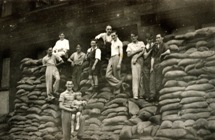
Well, I was a student during the war years. I entered university in 1937 and things were a bit tight shall we say in general. And I always remember the sorta bad news that was coming out of France just at Dunkirk time, and battleships being sunk off Singapore when the Japanese invaded Burma. And altogether it wasn't just say the brightest of times for an undergraduate, although at times I thought I couldn't see the country surviving but I always remember my father for some reason or other had complete faith that we would defeat Germany and win. And he was absolutely right.
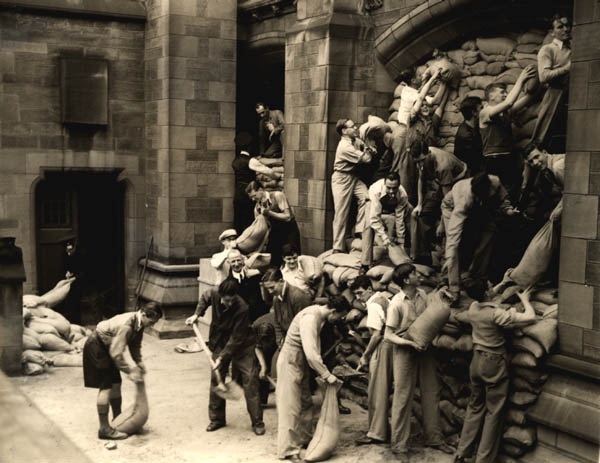 I remember that as part of your voluntary duties when you were a student at university, you were taken on to do warden along with a senior member of staff. You sat in some small room in the University, watching for aeroplanes or fires starting, so you know, that was part of our voluntary exercise for the University as a student. I can still remember the air raids in Glasgow Clydeside, Clydebank. And also remember in Springburn, I went down one night, nine o'clock to the Royal Infirmary and they had casualties in the surgical operating theatres and the surgeon allowed us in and we helped deal with these. There weren't terribly many, nothing like the London Blitz but at least you got a slight exposure to civilian casualties in the time of war but even the Royal Infirmary had nothing like what happened in Clydebank. And again, Clydebank patients probably all went to the Western Infirmary at that time. But still I saw one or two on one or two nights, it certainly kept your interest alive.
I remember that as part of your voluntary duties when you were a student at university, you were taken on to do warden along with a senior member of staff. You sat in some small room in the University, watching for aeroplanes or fires starting, so you know, that was part of our voluntary exercise for the University as a student. I can still remember the air raids in Glasgow Clydeside, Clydebank. And also remember in Springburn, I went down one night, nine o'clock to the Royal Infirmary and they had casualties in the surgical operating theatres and the surgeon allowed us in and we helped deal with these. There weren't terribly many, nothing like the London Blitz but at least you got a slight exposure to civilian casualties in the time of war but even the Royal Infirmary had nothing like what happened in Clydebank. And again, Clydebank patients probably all went to the Western Infirmary at that time. But still I saw one or two on one or two nights, it certainly kept your interest alive.
 Yes I remember the first time I started at the Royal Infirmary and you had to go down to what's now the accident and emergency or what was called the Gatehouse at the Royal Infirmary, to see the acute cases as they came in. And if you thought they were ill enough you moved them up to the ward. And I can remember I went down with another doctor and this individual, I think it was a man who came in gasping for breath, sitting bolt upright, blue in the face. And, I remember, I thought I could make the diagnosis, but I had a great difficulty in remembering treatment. I was almost not quite paralysed, but it showed me all the difference between book knowledge. I mean if somebody had said to me "this man is suffering from acute left heart failure, what's the treatment?" Well I could've run it through from the textbook. But when you saw the patient, what did you do? What did you give him? Hah, and it took me a long time to adjust from book knowledge to practical knowledge and giving it to the patient.
Yes I remember the first time I started at the Royal Infirmary and you had to go down to what's now the accident and emergency or what was called the Gatehouse at the Royal Infirmary, to see the acute cases as they came in. And if you thought they were ill enough you moved them up to the ward. And I can remember I went down with another doctor and this individual, I think it was a man who came in gasping for breath, sitting bolt upright, blue in the face. And, I remember, I thought I could make the diagnosis, but I had a great difficulty in remembering treatment. I was almost not quite paralysed, but it showed me all the difference between book knowledge. I mean if somebody had said to me "this man is suffering from acute left heart failure, what's the treatment?" Well I could've run it through from the textbook. But when you saw the patient, what did you do? What did you give him? Hah, and it took me a long time to adjust from book knowledge to practical knowledge and giving it to the patient.
It was a totally different type of medicine that I ultimately saw in India and Burma cause that was tropical diseases. And of course as undergraduate and graduate in the UK, your chances of seeing any tropical diseases were virtually nil. So this was a whole new world of medicine and I saw diseases that I’d only read about in textbooks. And they were diseases in very gross forms, for example, I was with West African Troops in India and Burma and you would hardly believe it but there was cases of advanced leprosy in East Africans. There was one ward in a base hospital in Leapoona where I worked for a few weeks or a month or two, a whole ward devoted to these advanced cases of leprosy. Of course other diseases, sleeping sickness, dysentery, amoebic dysentery, bilharzia, you know major diseases that killed thousands of people were commonplace in the hospitals.
![]() Changes in cardiology
Changes in cardiology
So you know from 1950 right onwards, cardiology as I say, expanded probably more than any other specialty in medicine and being in cardiology at that time I think I had the best years of it, seeing it all develop and all the techniques that are now used were a tremendous change from say the early 1940s, where investigations consisted of taking only an electrocardiogram. But then these invasive techniques arrived, cardiac catheterisation, revolutionised the investigation of heart disease. And with the development of surgery, the treatment of certain heart diseases just opened out and also the introduction of so many new drugs extended the therapy for patients suffering from heart disease and altogether it made a tremendous difference looking back at what it was like when you started out in the early 1940s.
Well, I developed a problem with heart rhythm in I think about the late eighties, resulting in heart block for which the treatment was insertion of a pacemaker and of course it made a tremendous difference. So I had a pacemaker inserted. It lasted for ten years and then it had to be replaced, so I’m on to my second pacemaker. So at that time I had a fair idea of what it was like to be a patient. You know initially, part of my clinical commitments was the coronary care unit, when I got a heart block I landed as a patient in what was previously my own coronary care unit, so in fact got a taste of my own medicine.
Ms Olivia Brittian
Ms Olivia Brittian
Listen to Ms Brittian's nursing memories
![]() Nurse training in 1963 at the Victoria
Nurse training in 1963 at the Victoria
Yes, I started nurse training in 1963 in the Victoria Infirmary, in the southside of Glasgow. In those days, all nurses were trained in a hospital and you just chose the hospital that you wished to go to. I chose the Victoria Infirmary in actual fact as they treated my brother after a bad accident and actually saved his arm and I felt that they were a good hospital. The training in 1963 was very much ward based. You had opportunities to go into the classroom and learn but then most of your actual education or training was on the wards themselves and it was very much a 24/7 training in that you had to do day duty, night duty, evening shifts, split shifts and you could be on night duty and have to come off in the morning and go for lectures, because if you were in the middle of a medical block, maybe a consultant would be coming to teach about a particular disease process. I did a four year course because I combined both general nursing and orthopaedic nursing just because I was just a few days seventeen when I started the course.
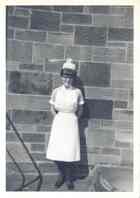 I completed that in November 1967 and worked as a staff nurse in the Victoria Infirmary for six months. And that was required of you, that you had to work six months to a year in the hospital that trained you, just to pay them back and one of the good things about it was that you had to in actual fact stay in a nurses' home so you were very much part of a group, part of a hospital, you felt pride in your hospital and you know, that was your training hospital. You had your hospital uniform, which was different from any other hospital in Glasgow so there was great pride about the actual hospital and there was great rivalry I must say in the different hospitals in Glasgow even at that time.
I completed that in November 1967 and worked as a staff nurse in the Victoria Infirmary for six months. And that was required of you, that you had to work six months to a year in the hospital that trained you, just to pay them back and one of the good things about it was that you had to in actual fact stay in a nurses' home so you were very much part of a group, part of a hospital, you felt pride in your hospital and you know, that was your training hospital. You had your hospital uniform, which was different from any other hospital in Glasgow so there was great pride about the actual hospital and there was great rivalry I must say in the different hospitals in Glasgow even at that time.
And in the beginning of 1987 I came to Glasgow University, more as a clinical teacher in community nursing rather than as a lecturer and at that point in that year, there ended up there was five of us who were in that same boat, others doing the acute setting or elderly and myself doing the community and that lasted for about three years and our salaries were, seconded here to the university. Our salaries were paid by a professional body but in 1990 the university took us over, as lecturers. And because of that and looking at the job specs, you actually had to have a first degree to be a lecturer here so the five of us ended up having to try and do degrees and because of my background in community nursing, a new degree had started here in the university in 1990, between the Medical Faculty, Public Health and Social Science, it was called Master in Community Care. It was very appropriate to what I was doing so I didn't get on the first cohort because it was very popular, got on the second cohort and graduated with that, a Master in Community Care in July of 1993.
And one of the advantages of the course here at Glasgow University which started in 1978, right from the beginning it had a great emphasis on community. And it wasn't really until 1990 that general nurse education moved from hospitals to actual colleges of higher education and the courses had to, what it was called Project 2000, you might hear that coming up. These courses had to be half for theory for community and half for general and it was the same with the actual experience that the students got and the idea was that the students should be able to work either in the community or the hospital on finishing their course on registration.
In 2000 I actually became the admissions officer which is a Medical Faculty appointment for the school and a few years later became the course director, the undergraduate course director and last year became the deputy head of the school. So you know it's been quite a progression and I think it's encouraging too for people who did my training, that they can see that they can develop academically as well as practically because it's good. What we like about our posts here is that we still have a clinical remit in that we go out and visit students in their clinical area. So you're keeping up your knowledge and knowing about the new skills, you haven't got them but at least you know the type of skills that the students require so you can teach very much from a practical basis as well as the theory behind it. Which is good. It's maybe different from other lecturers in other courses who are just literally teaching their subjects like French or ever what it is, you know we are teaching it very much from evidence base and from what's happening out there in practice. We change the experiences that students have depending on what's happening out in the health board as well so it's good.
![]() Skills and knowledge from the ward and the University
Skills and knowledge from the ward and the University
Well I think that the major change that I see is when I went forward as a registered nurse, I probably was very confident in my skills but I hadn't the same depth of knowledge. Looking at our students today who are going to graduate in December [2006], they have a lot more depth of knowledge and particularly about the science aspect of the course. They may be not so confident in their skills but we don't see this as a problem because they will develop that confidence in their first clinical placement or first post as a staff nurse and as a new staff nurse they have changed legislation in that every new staff nurse in their first post should have what's called a preceptor to look after them and that is really to help them develop both their knowledge in running a ward but also gain confidence in their skills, so there's somebody who will oversee them and they can go to them if they've got any problems. So at the end, six months post registration I think we produce, not just ourselves but graduate degree programmes do produce a real good nurse who has both got the clinical and the theory behind what they're doing.
And one of the other major changes that I think is good in nurse education, now a professional body is advocating lifelong learning. So that when I trained, you did your registration, you went to work, some people went on to do midwifery or other courses but it was never sort of expected of you and you had to renew your registration every three years. But there was no stipulations about that, it was just that they wanted your money. But now, you still have to renew your registration every three years but you in actual fact have to prove to our professional body that you're keeping up to date. You have to do five study days each year or every three years. For ourselves here, the study days are not a problem because we do so much reading and all the rest of it. We have to prove to them that we do 750 hours clinical in three years to make sure that we can keep on the register. So that is all about being a safe practitioner.
Professor Rhona MacKie
Professor Rhona MacKie
Click on the links below to listen to Professor MacKie remember life as a student and teacher
Well, I graduated in 1963 and I think, probably throughout most of my schooldays I had planned to be a vet. I was very fond of riding, spent a lot of time around horses and knew a lot of vets very well. However, probably from the age of about fifteen, sixteen I slightly switched from deciding I wanted to look after animals to deciding I wanted to look after people. So that's how I came to study medicine.
Oh, lots of memories, a lot of fun. It's interesting, responding to your email, the first thing I remember was at our freshers' camp, which was meant to be down at Loch Lomondside, I think at Rowerdennan, was cancelled because of Asian flu. Now there's all these worries about bird flu around nowadays, you realise that nothing changes. So, we didn't have a freshers' camp, so a friend who went on to study science and I went off youth hostelling. Thoroughly enjoying ourselves for a few days and then got going on the university scene which I enjoyed very much.
![]() Happy memories of the QM Union
Happy memories of the QM Union
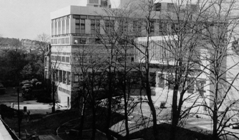
I was very much involved in the Women's Union. In those days, Queen Margaret Union was women only. I was involved in helping run it. And therefore saw a lot more of the general student scene than perhaps some medical students do. So I enjoyed my university days. I've got very happy memories of them.
When I graduated I knew I wanted to be a hospital specialist, I didn't want to be a GP but I also knew I that I wanted to try and combine a mixture of direct clinical contact with patients. I wanted to have my own patients with some kind of lab work. I enjoyed pathology. And, at that time, looking around at the possibilities, the two specialties which looked as if they might be able to offer me this mixture were clinical genetics, medical genetics and dermatology. And an opening came up in dermatology, which I took. There was a lot of interesting good dermatological pathology in Glasgow at that time and that's how my career got started.
I suppose someone has to do it, so if you like. This was 1978. I was an NHS consultant in dermatology at that time. I was very interested in research. Although I enjoyed my clinical work, the research clinical care balance was not quite what I was looking for. I had appointments for example to three different hospitals, to the Western Infirmary, to the Southern General and to the Royal Hospital for Sick Children. And you did feel as if you were being pulled in different directions very strongly. You wanted to play a full part in helping in these hospitals but you also wanted to keep some research going. I had teaching commitments, I've always enjoyed teaching. And I found that this, very mixed consultant job wasn't quite what I was looking for. So I applied for the chair when it became vacant, was interviewed along with four other colleagues, three other colleagues as I remember all of whom went on to become Professors elsewhere, and was offered the job and was delighted to accept it.
My main interests throughout my time in dermatology for many years now has been the form of skin cancer called melanoma. And that really stemmed very much from meeting one patient when I was doing my surgical pre-registration jobs, working on the south side of Glasgow and coming across a patient lying in a surgical ward with very extensive melanoma involving most of one of his legs. He had been on one of the ships berthed down at Greenock. In those days there was plenty of ships coming in and out of the Firth of Clyde. This poor man spoke no English, and it was clear that none of my senior surgical colleagues, my bosses in those days knew what to do for him. And it was very sad for everyone and very thought provoking to see a patient lying there, desperately wanting to know what was going to happen to him. He didn't speak English. We had no interpreters in those days. The surgeons obviously didn't quite know what to do. And it made a very big impression on me this interesting disease called melanoma that no one in Glasgow seemed to know how to treat. Or no one in the hospital I was working in knew how to treat. And that really sparked off my interest in melanoma. Not just in melanoma, but also in patient communication, and treatment plans and guidelines which has been part of my life ever since.
![]() Changes in melanoma, good news and bad news
Changes in melanoma, good news and bad news
Good news and Bad News. We have good teams who work on melanoma in the West of Scotland. Patients come for treatment earlier thanks to public education programmes, explaining to them what early melanoma looks like. The outlook for a patient with melanoma, the survival figures have improved hugely over thirty years, which is satisfying. That's the good news, the bad news is that more people are getting melanoma. The incidence is continuing to rise. Almost certainly due to more sunny holidays, more sun exposure on unaclimatised white Scottish skin. So improvement in how we manage melanoma but a much needed improvement in terms of the numbers of people we have to look after.
I think as far as dermatology is concerned, some of the changes I've seen have been perhaps to my mind, disappointing. Dermatology when I did it, was interesting in that we had large wards. We looked after patients with connective tissue disease, with lupus erythematosis, with systemic sclerosis. We looked after patients with sarcoid. And you had a very interesting mixed collection of people to look after. Gradually a lot of these interesting medical dermatology problems have been taken over by other people. Nowadays of course, we have the specialty of rheumatology, which didn't exist back in the 1960s. And many of the connective tissue patients have gone to rheumatologists. Similarly many of the sarcoid patients have gone to the respiratory physicians. So, the medical aspect of dermatology is really very much smaller than it used to be and there is a growing tendency for dermatology to be interested in more cosmetic aspects, which wasn't what I did medicine for. So I think if I were looking for a specialty now as a young graduate, I might not choose dermatology I might well choose rheumatology for example.
![]() Teaching and learning the new curriculum
Teaching and learning the new curriculum
I've always enjoyed teaching, both undergraduates and postgraduates. And watching the new curriculum develop has been very interesting, very stimulating. Nowadays so much of the teaching is done in small groups with problem solving exercises. I find it interesting and stimulating to teach and I think the students find it interesting and stimulating to learn. They no longer have to learn a lot by rote but they work it out for themselves. And I find that creates a very nice atmosphere between student or learner and teacher, where everyone is discussing things together. And I think the success of the new curriculum is very obvious when you look at the number of people who want to study medicine in Glasgow. The word has obviously gone around that it's an interesting lively and good place to be. And I would agree with all of these things.
Professor Macfarlane
Professor Macfarlane
Listen to Professor Macfarlane's soundbytes
Well, at university my first degree was in Mathematics and Natural Philosophy and towards the end of that degree Professor Sneddon announced to the class one day that he was trying to find a student who might be interested in working in the Royal Infirmary in the cardiology department looking at techniques for analysing electrocardiograms using computers. So, I had always had an interest in health physics and I jumped at the opportunity, met Dr Lawrie and Dr Wright as they were at that time and got the post of research assistant. So I started in the Royal Infirmary in 1964 on August the 1st and, was supervised as a research student by Professor Sneddon in Mathematics and Dr Lawrie in Cardiology and we just started with a pencil, paper and an empty room and took things forward from there. In 1966, the University Department of Medical Cardiology was formed with the support of the late Lord Fraser and in 1967 I became an assistant lecturer in Medical Cardiology and that really set me off in my university career. So, for the past forty years or thereabouts I've been busy trying to find ways of successfully analysing ECGs by electrocardiograms and we're still looking for the answer in many cases.
![]() Pacemaker check - in the mortuary
Pacemaker check - in the mortuary
I do remember in the early days on one occasion on a Saturday morning I was asked to come in to the mortuary specifically to record an ECG on a patient who had been brought in to the hospital having died twenty four hours previously and the regional department of clinical physics was interested in knowing if the patient's pacemaker was still working, the patient had one of the earliest implanted pacemakers in the city and therefore there was some anxiety about whether the pacemaker had failed, so it was very strange to record an ECG on a corpse, and in fact the pacemaker was still working. So with the corpse lying there connected up to an ECG machine, there was a regular stimulus being emitted from the pacemaker and being recorded on the paper as it was at that time, very strange, and unforgettable.
![]() Developments in technology, from basements to briefcases
Developments in technology, from basements to briefcases
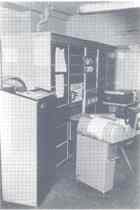
Well, in the early days we only had access to a University of Glasgow computer called the KDF9 and that was located in the basement of the old chemistry building, well it's still the chemistry building and it occupied a huge area, greater than the penalty area in a football pitch to give you some idea of the size of a computer in those days. So it was very inconvenient to have to go to the University from the Royal Infirmary every time you wanted to do an analysis of any data. Gradually the size of computers reduced but nevertheless we used to have a computer committee in the Royal Infirmary and anybody who wanted to purchase a computer to use as a part of their medical research had to make an application to a committee to obtain the funding to purchase a computer. It's almost unthinkable nowadays given the power that each of us can have in a little microprocessor based device in our pocket. However in the late sixties, a small laboratory based computer became available known as a PDP8 and that allowed us to record ECGs within the hospital and feed them into a computer for analysis. The equipment nevertheless still occupied half of a modest office. However as everybody knows microprocessors gradually evolved and the power of these devices is even greater than was in the laboratory based computers of the early 1970s. The size of the equipment required to analyse an ECG has dropped dramatically, so much so that a briefcase sized ECG machine these days can record and store and interpret an ECG. Interpretation takes a matter of seconds and indeed the machine can be connected up to a radio network or hardwired to a central computer to transmit all the data for storage centrally. So, in the early days of ECG recording, there were mountainous amounts of paper being stored in files in the ECG department and nowadays the hospital load of say 30,000 ECGs per year is stored centrally on a computer and all the paper files have disappeared. So there's been tremendous developments in technology leading to miniaturisation of equipment and techniques that were unthinkable forty years ago are now an everyday commonplace part of medicine.
Ms Anne Jarvie
Ms Anne Jarvie
Listen to Ms Jarvie's memories of her career in nursing
![]() Everyone in hospital is cruel?
Everyone in hospital is cruel?
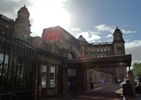 It was the one thing that I said when I was growing up I would never do, because my sister had been in hospital for quite a period of time including her fifth birthday and I'd not been allowed to visit her at all and I made the assumption that everybody in hospital was cruel if they would do that to a sister. So it was a thing I did not want to do but one day, when I got off a bus at home, one of the local GPs who was a family friend stopped the car and said "come and I'll take you home". And he said to me that he had dreamt that I was nursing in Glasgow Royal Infirmary. So I said to him, "well my goodness you've not got a lot to dream about if that's what you dreamt about". But for the next few months it obviously niggled at the back of my head and I decided that I would at least write to Glasgow Royal Infirmary and ask for information about nursing and before I knew where I was I had started and never regretted it.
It was the one thing that I said when I was growing up I would never do, because my sister had been in hospital for quite a period of time including her fifth birthday and I'd not been allowed to visit her at all and I made the assumption that everybody in hospital was cruel if they would do that to a sister. So it was a thing I did not want to do but one day, when I got off a bus at home, one of the local GPs who was a family friend stopped the car and said "come and I'll take you home". And he said to me that he had dreamt that I was nursing in Glasgow Royal Infirmary. So I said to him, "well my goodness you've not got a lot to dream about if that's what you dreamt about". But for the next few months it obviously niggled at the back of my head and I decided that I would at least write to Glasgow Royal Infirmary and ask for information about nursing and before I knew where I was I had started and never regretted it.
![]() Nurse training at the Royal 1965
Nurse training at the Royal 1965
I started nurse training in September 1965, here at the Glasgow Royal Infirmary and Associated Hospitals School of Nursing in the days when Matron was head of the Nursing Services in Hospital and also in the School of Nursing.
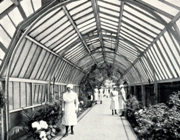 We were also resident. We had to live in for at least the first year. You could get permission to live out in the second year providing you were going to live at home. And you could get permission to live out in your third year in a flat providing your parents gave permission for that to happen. So we knew each other very well because we were resident and in those days when you were on night duty as a student nurse, you didn't stay in the nurses' home in the Royal you went down to Belvidere, meant to be quieter and that you would get sleeping during the day. But I think the relationship between, doctors and nurses was substantially different in those days because everybody worked longish hours. Because people were resident they got to know each other in quite a different way and there was quite a bit of social activity within hospitals so it felt very much being part of a team.
We were also resident. We had to live in for at least the first year. You could get permission to live out in the second year providing you were going to live at home. And you could get permission to live out in your third year in a flat providing your parents gave permission for that to happen. So we knew each other very well because we were resident and in those days when you were on night duty as a student nurse, you didn't stay in the nurses' home in the Royal you went down to Belvidere, meant to be quieter and that you would get sleeping during the day. But I think the relationship between, doctors and nurses was substantially different in those days because everybody worked longish hours. Because people were resident they got to know each other in quite a different way and there was quite a bit of social activity within hospitals so it felt very much being part of a team.
![]() Night duties and responsibilities
Night duties and responsibilities
It was quite scary some of it on reflection, in that from your second year on the chances were, that when you were on night duty, you might just be in charge of the ward. Now these were all acute wards, they were wards that took their turn receiving every four nights or thereabouts, and there we were in training, not having gone through the full theoretical component of the training let alone the practical component and yet were responsible for what was going on in that ward or department at night. None of us I think had the insight maybe to realise just how scary that was because it was normal but I think maybe we were lucky to do as well as we did given the circumstances.
I worked in the acute renal unit there at the time when there was the ghastly period of hepatitis that was affecting both the patients and the staff with some dying so it was quite a tense time but anecdotally when I think of how we have to be covered now, up on the notice board in the acute renal unit was a little one liner almost from the chief, you won't remember but we used to have chiefs, the consultant in charge of the team of consultants and he had written up "I cover nurses to do whatever nurses need to do in the interests of good patient care", because none of the doctors were resident during the night, they all went away home so if a patient needed anything we gave it and then said to them in the morning.I cover nurses to do whatever nurses need to do in the interests of good patient care
When I started, on the whole, they way care was delivered was very task orientated so when you came on duty you would usually be given a little slip of paper and you would know whither you were the person who was responsible for fluids that day or whether you were responsible for doing the dressings, or whatever, so things were broken down into discrete tasks, as it was perceived. That was the way that you could get through the very busy agenda. But it did mean that you played tig with the patients a bit because, I would go and maybe do the bed bath if that's what I was doing today and then somebody else would come along a little while later and almost undo some of what had been done because the dressing had to be done and somebody else would come along and try and push fluids, so there was not that opportunity to really support the patient through all the activities that they needed on that particular morning, afternoon or evening.
The prime responsibility was to be the advisor to Ministers, to colleagues within the Home and Health Department and across the whole of the Scottish Office as it was then as was necessary on all things to do with nursing, midwifery and health visiting. So that was the prime responsibility but increasingly over the years, the responsibility for leading nursing and midwifery in Scotland became much more evident and much of my time was spent out with people in the NHS or indeed in the private and independent sector, trying to challenge them and excite them as they went about their daily duty of caring for patients, and their relatives and friends. It was a very privileged position to be in. I had a number of ministerial colleagues during that time, of course went in at a time when it was the conservative government and then things changed in 1997 when we had a labour government.
Mr John Fleming
Mr John Fleming
Listen to Mr John Fleming discuss his career and interest in ultrasound
I moved from the south of England in 1962/63 to work on medical ultrasound in Kelvin and Hughes or S Smith and sons, I think it was called at that time. Ian Donald was collaborating with Smiths in developing ultrasound machines. And they employed me as an engineer in Kelvin and Hughes and then Smiths, interchangeable with Hughes and then the company decided there wasn't any money in that particular area and they closed the whole Glasgow factory. So, it was a bit upsetting. I'd only been in Scotland five years and I didn't quite know what to do. And then Ian Donald was distraught because all his work seemed to stop and the principal fortunately just said to him, "Well what do you want to do? Do you want to employ somebody?" And so he did. And well you can't just have one; you've got to have two people. So I got an offer of a job, and so I said to a colleague who'd actually left Smiths and gone to IBM, "Do you want to come back into ultrasound?" And so Angus Hall also came and the two of us set up a department, a small unit on medical ultrasound and we did technological developments that improved the machines, which were pretty crude in those days and worked with doctors and various research projects. And I was employed by the University for thirty years and although I've retired I'm still working for them, just part time. It's the history project for the last twenty-five years that's gradually become dominant in my contribution to the ultrasound.
I obtained a Higher National Certificate in electrical engineering which, was covered electronics. I had been working at EMI, actually for Godfrey Hounsfield who later went on and developed CT imaging [Computerised Axial Tomography]. He wasn't doing that while I was there, we were building computers that wouldn't fit into this room. And then I went to Ferranti, before coming up to Scotland. But Ferranti was all in mostly in military projects, radar systems and air defence and things like that. And I really didn't like working on that. That's why I moved into the medical field. Well I'm very glad that I did. I thoroughly enjoyed it. I still am enjoying it.
Well, I was involved in the history of medical ultrasound something like twenty-five years ago. The British Medical Ultrasound Society had got to the point where it saw it needed more of an educational activity. And they thought a historical collection would be one way of contributing to that. Some years earlier, Tom Brown who developed the, the first machine for Ian Donald had given it to me to look after because we had a bit more space here than he had in his garage. And so we had this, as we affectionately call it, the ‘bed table scanner’, because it was built on to an old hospital bed table. It was a very crude piece of equipment, built in just a few weeks using industrial ultrasound equipment used for detecting flaws and cracks in metal. So I had this item and the British Medical Ultrasound Society knew I’d got this of course, so they said to me, “Well you’re ideally placed to start a collection, would you like to do so?” So I said “I’ll try”.
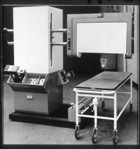 Now of course everybody's got ultrasound it's just common, so common, nobody thinks it could never have been there. But the historical collection, exhibition that's being opened in the Hunterian next week or whenever, is going to show the first scanner that was built before I was involved. It was built by Tom Brown for Ian Donald to use. It looks a very crude piece of equipment but it produced images, which had not appeared before and showed possibilities.
Now of course everybody's got ultrasound it's just common, so common, nobody thinks it could never have been there. But the historical collection, exhibition that's being opened in the Hunterian next week or whenever, is going to show the first scanner that was built before I was involved. It was built by Tom Brown for Ian Donald to use. It looks a very crude piece of equipment but it produced images, which had not appeared before and showed possibilities.
![]() Collaborating on the first scan
Collaborating on the first scan
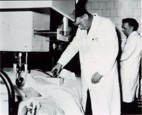 I wasn't actually there. But Tom Brown says he's got a copy of the first scan and well it was really rather disappointing. Because it didn't show much information, compared with the pictures we see today it was very disappointing I suppose. But on the other hand it was a picture that people had to learn how to interpret them. That was a very big part of it. And that's a big part that Ian Donald played. He of course was an obstetrician and gynaecologist and quite a practical sort of man of course but he didn't have the knowledge and skill to design the electronics anyway but he could say what he wanted. So it was interesting to see the interaction between engineers sort of like myself and people coming from the medical side and trying to work together and understand one another.
I wasn't actually there. But Tom Brown says he's got a copy of the first scan and well it was really rather disappointing. Because it didn't show much information, compared with the pictures we see today it was very disappointing I suppose. But on the other hand it was a picture that people had to learn how to interpret them. That was a very big part of it. And that's a big part that Ian Donald played. He of course was an obstetrician and gynaecologist and quite a practical sort of man of course but he didn't have the knowledge and skill to design the electronics anyway but he could say what he wanted. So it was interesting to see the interaction between engineers sort of like myself and people coming from the medical side and trying to work together and understand one another.
![]() Ultrasound - a simple explanation
Ultrasound - a simple explanation
The most common sort of ultrasound scans these days are two-dimensional images. Well actually Ian Donald had a very good analogy. If you imagine a sliced loaf and you pull out one slice from the middle of the loaf, that shows you a section through the loaf. Well that really is what an ultrasound image is doing. You might enhance the idea by, as you pull it out you see that, there's drawn on the slice of bread is a section through the spine at the bottom and perhaps a big clear area that is the bladder, a section through the bladder, the bladder being just virtually water, there are no echoes from it, so it just looks black on the picture. Whereas the layers of tissue, the muscle, the abdominal wall show white usually. And you can, when you think about it you can see the structure, the sections through the muscles or, other sections you would see the uterus, and the developing foetus within it.
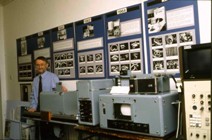 And then over the subsequent years, I built up a collection which is now stored in the Hunterian Museum. I've probably given them a bit of a problem, and there's quite a lot of equipment. And in addition we've accumulated a lot of archive material which is now transferred to the NHS Archive in the care of Alistair Tough, where it will be kept properly indexed and made much more accessible than it was here and well cared for which is the important thing. And it's difficult to show much of the hardware of course, that's there for research and interest but very happily, that original scanner is going on display in the Hunterian Museum's new medical exhibition, opening in May. And it will be in its glass case on permanent display. So, looking forward to seeing that happen very much. And at the opening the man who designed it will be there I hope.
And then over the subsequent years, I built up a collection which is now stored in the Hunterian Museum. I've probably given them a bit of a problem, and there's quite a lot of equipment. And in addition we've accumulated a lot of archive material which is now transferred to the NHS Archive in the care of Alistair Tough, where it will be kept properly indexed and made much more accessible than it was here and well cared for which is the important thing. And it's difficult to show much of the hardware of course, that's there for research and interest but very happily, that original scanner is going on display in the Hunterian Museum's new medical exhibition, opening in May. And it will be in its glass case on permanent display. So, looking forward to seeing that happen very much. And at the opening the man who designed it will be there I hope.
Mr Robert Shaw
Mr Robert Shaw
Listen to Mr Shaw describe his experiences of the Heart Transplant Unit of the Royal Infirmary, Glasgow
The problems started in December '91 just before Christmas when I had a stroke and finished up in Stobhill hospital. I was eventually discharged and was unwell for quite a while and got back to work in May '92, lasted about a month and after that I was in and out of hospitals for various tests and assessments. And finally in Stobhill, at the beginning of in December '92 right through until they transferred me to the Glasgow Royal for a heart transplant.
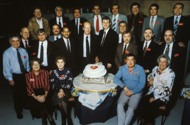 The transplant unit had been opened about a year. I was number twenty seven on the list of famous ones. Of course the thing was when I was lying in Stobhill after my stroke, they had just opened the unit and there was a lot of publicity in the paper about it, you know. And previous to that, Dr Dunn the cardiologist had said, "they can do wonderful things for you in the Glasgow Royal". And ever since then when I was in his examination couch he mentioned this, I used to slide down the couch in fear. But here I am today.
The transplant unit had been opened about a year. I was number twenty seven on the list of famous ones. Of course the thing was when I was lying in Stobhill after my stroke, they had just opened the unit and there was a lot of publicity in the paper about it, you know. And previous to that, Dr Dunn the cardiologist had said, "they can do wonderful things for you in the Glasgow Royal". And ever since then when I was in his examination couch he mentioned this, I used to slide down the couch in fear. But here I am today.
![]() Nurse barbers - memories of the op
Nurse barbers - memories of the op
The worst thing I remember, being in intensive care, of all things to say, it was the day the nurses decided to give me a wet shave. And it was absolutely agony, hospital razors, being shaved by two nurses. Other than that I can't remember much about anything, you know. Other than the breathing machines down your throat, and think causing a lot of people a lot of trouble.
You got to know the staff on the ward well, and as I said, I spent a fortnight on the ward then a couple of weeks in the flats but one day I think I was in the flats or in the dining room and this lady came over to me and said, "nice to see you vertical Mr. Shaw". And of course, not having a clue who she was I eventually found out, this was the anaesthetist at the operation with me. And she remembered me, I couldn't see her face but she must have seen mine. And I got the general idea, she was quite pleased to see me sitting up at a table I suppose.
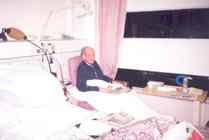 When I was in Stobhill, they were waiting to start digging the hole for me. Of course, two of my work colleagues came in to see me just, at least two days before I had my operation. And when I next saw them, after the operation, they said they were going home to look out their black ties. That would give you an idea how bad I was.
When I was in Stobhill, they were waiting to start digging the hole for me. Of course, two of my work colleagues came in to see me just, at least two days before I had my operation. And when I next saw them, after the operation, they said they were going home to look out their black ties. That would give you an idea how bad I was.
I've enjoyed the transplant games. In fact I went to the first transplant games in '93, as a sort of visitor although I didn't qualify, because you must be transplanted a minimum of six months before you can compete. So, the unit was going as part of the Glasgow team for the first time ever in, that must have been July, July '93, down to Newcastle. And I've managed to be in every, at every transplant games since then, competing in various things, from golf, badminton, and the walk. I've had, had bronzes in badminton. The opposition in the golf was too much for me.
That was a photo call for donor week run by the Scottish Executive, they wanted a patient to sit in the this specially purpose built settee with the back of it shaped liked a heart in George Square and get your photograph taken with one of the co-ordinators. It was in the Evening Times, the Glaswegian and the local paper as well. And it was a bit of publicity, so it was relatively easy to do and quite interesting.
Dr Selena Gleadow Ware
Dr Selena Gleadow Ware
Click on the links below to listen to Dr Selena Gleadow Ware talk about her
![]() Interest in studying in City of Culture
Interest in studying in City of Culture
I think generally for medicine I’d always been interested in the human body and how that worked and interested in a career that was kind of giving things back to people, helping people really. And Glasgow, well, coming from London, I wanted to go to a city that was big enough to keep me busy and have lots of things to offer and also the fact that it was five hundred miles away from home was a bonus at that time. Also there’d been quite a lot of media coverage around that time about Glasgow, you know, an important city in terms of culture and things like that. It sounded like the place to be as a student at that time.
I think generally at Glasgow University, we had quite good fun on the course at that time. We were the second year of the new course, and I think the University were just kind of getting to grips with how it was all working which probably meant they were a bit easier on us than they have been on years subsequently. So it meant that we could be really flexible in kind of our own approach to learning and studying which was I think helpful in terms of motivating yourself but also in terms of being able to arrange your social life.
I really enjoyed the kind of extra curricular kind of activities side at Glasgow Uni' which I think is one of its great strengths. In particular I was involved with one of the groups, Student Action for Refugees. And we had great fun organising publicity stunts, sitting in a bamboo cage outside the library in the pouring rain! Highlighting the plight of refugees in detention.
Yeah, I really enjoyed Public Health, I think that was kind of fuelled by our enthusiastic head of first year Dr. Phil Hanlon, who was brimming with enthusiasm for Public Health. So I kind of got interested in it and took the opportunity to do an extra year and specialise in that.
![]() Choice of Psychiatry as specialty
Choice of Psychiatry as specialty
Since I've graduated, I did the kind of usual junior house officer year, and after that I kind of went into psychiatry actually which I found really interesting, quite challenging at times and you know nobody presents in the same way with their illnesses. The fact that you know it's a really supportive place to work and everyone's really friendly and there's a lot of emphasis on teaching and the fact that you have great team support, both in the community with the psychiatric nurses and within the hospital setting, and, and that you know the consultants are all approachable and very friendly as well.
Yeah, I think probably tinged with fear for the first few days. You know I think it was just very busy in those days. I think life as a junior doctor is maybe changing slightly now and there's a lot more capping on kind of hours and nightshifts and things like that. But certainly, just the kind of the sheer volume of work I think was a bit of a shock to the system when you first started out on the wards.
I really enjoy also psychiatry because it enables me to have a fairly good work life balance although obviously it can be busy at times. And that means I can still be involved in the activities that I started as a student. In particular I'm involved with a kind of food initiative charity in the north of Glasgow, which is about addressing the kind of food poverty issues of the North of Glasgow, cause you can quite easily forget that Glasgow is one of the most deprived cities in Europe really, if not the Western World. And that there are ongoing challenges for that and I've really enjoyed getting involved with this kind of food charity and helping them continue with their work as well as getting experience of my own on staff management and other kind of matters.


